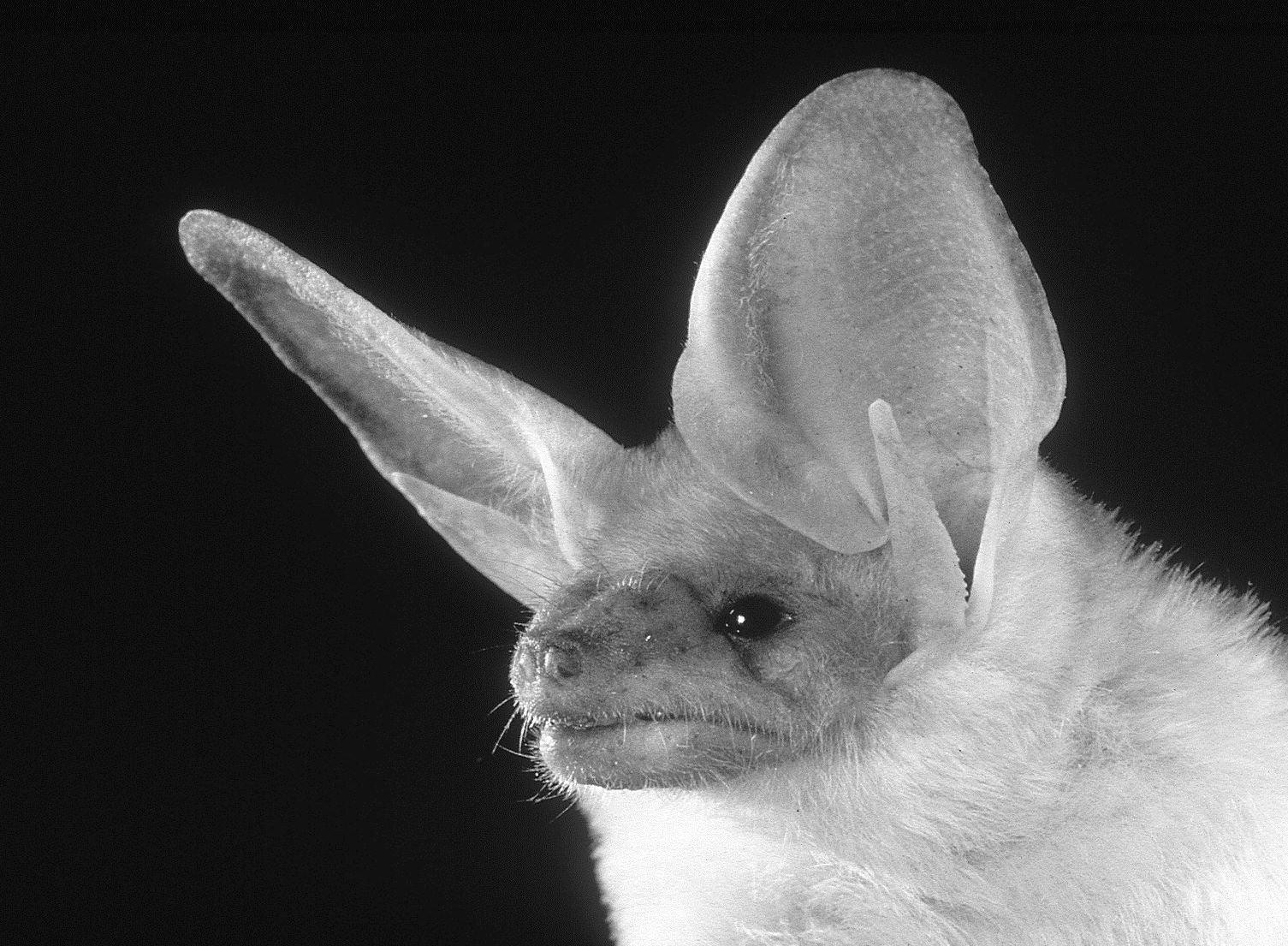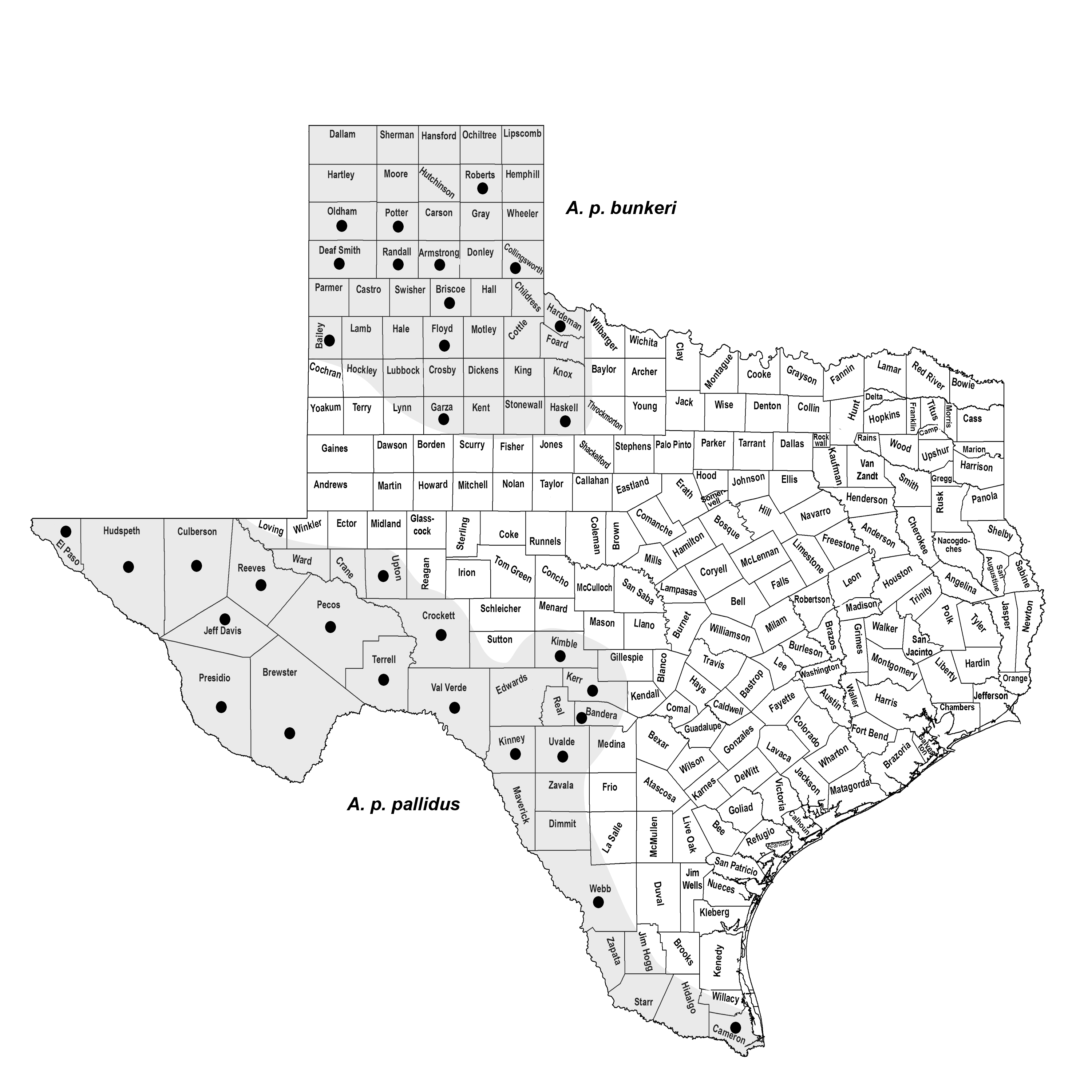PALLID BAT
Antrozous pallidus (Le Conte 1856)
Order Chiroptera : Family Vespertilionidae
DESCRIPTION. A rather large, pale, yellowish-brown bat. Ears about 2.5 cm long, broad, naked, and crossed by 9 or 11 transverse lines; bases of hairs light (nearly white), tips dusky; large light spot between shoulders; underparts paler and lacking dusky-tipped hairs; membranes nearly naked and brownish; nostrils surrounded by a glandular ridge producing a blunt snout; feet relatively large and strong. Dental formula: I 1/2, C 1/1, Pm 1/2, M 3/3 × 2 = 28. Averages for external measurements: total length, 113 mm; tail, 46 mm; foot, 12 mm; ear, 28 mm; forearm, 48 mm. Weight, 12–17 g.

DISTRIBUTION. A common resident of the western half of Texas. It has been recorded from the High Plains, Rolling Plains, Trans-Pecos, Edwards Plateau, and South Texas Plains vegetational areas.

SUBSPECIES. Antrozous p. pallidus over most of the far western and southern part of its range in the state; A. p. bunkeri in the Panhandle (northern High Plains) and adjacent parts of the Rolling Plains.
HABITS. Pallid bats inhabit rocky outcrop areas where they commonly roost in rock crevices, caves, and mine tunnels, but they also roost in the attics of houses, under the eaves of barns, behind signs, in hollow trees, and in abandoned adobe buildings. Colonies are usually small and may contain 12–100 bats. Pallid bats usually appear on the wing relatively late at night, well after dark. Although occasional individuals have been reported from the United States in winter, their winter habits are poorly known. The species appears to migrate on a limited basis, and the bats are thought to move locally to deep recesses of mine shafts or caves to avoid cold winter weather. Their feeding habits are unlike those of most American bats. For years, naturalists have noted the kitchen middens of discarded wings and other hard parts of insects under their feeding roosts. Among these middens were remains of Jerusalem crickets, scorpions, and other flightless arthropods, although the pallid bat diet also includes flying insects. To some extent, though, pallid bats are terrestrial foragers. Their diet appears to be substantially different from the availability of insects in their local environment, suggesting they are selective foragers. They have been observed flying, apparently at random, over an area at levels of 15–90 cm above the ground. When prey is located, often by passive sound (in addition to echolocation), the bat abruptly drops to the ground, searches briefly, grabs its victim in its mouth, and takes off. Captured prey may be eaten on the ground or carried to a night roost or feeding station for consumption.
Other than the items mentioned above, pallid bats also eat moths, froghoppers and leafhoppers, June beetles, and grasshoppers. In fact, 54 different types of prey have been documented for the pallid bat. Large night-flying insects and ground-dwelling arthropods are most prevalent in the diet, however. A study conducted in the Indio Mountains of Hudspeth County, based on culled parts of prey found under a night roost, found that grasshoppers and crickets were the most common preyed-upon group (44.1%), followed by beetles (26.8%), sun spiders (16.2%), moths (3.5%), walking sticks (3%), and true bugs (2.7%). Apparently, their diet is quite variable both geographically and seasonally. In addition to arthropods, they also are known to eat lizards and small rodents.
Mating occurs in fall, with parturition in early summer. Females may carry one to four embryos, but the birth of twins is typical. The length of gestation is 53–71 days. In Texas, the baby bats are born in early May to mid-June. Newborn bats weigh approximately 3 g and seem to develop more slowly than other species. The eyes open at 8–10 days of age, hair is evident at 10 days, and the young are volant by 6 weeks of age. Young bats have been found to contain both milk and insect remains in their stomachs, indicating that the young continue to nurse after becoming volant.
POPULATION STATUS. Common, year-round resident. This species is one of the most abundant bats in the western part of Texas. Pallid bats are the second most common species captured in Big Bend National Park; only Brazilian free-tailed bats (Tadarida brasiliensis) are more abundant.
CONSERVATION STATUS. The pallid bat is listed by the IUCN as one of least concern because of its wide distribution, presumed large (stable) populations, and occurrence in a number of protected areas. It does not appear on the federal or state lists of concerned species, and at this time there seems to be little reason to worry about its status in Texas.
From The Mammals of Texas, Seventh Edition by David J. Schmidly and Robert D. Bradley, copyright © 1994, 2004, 2016. Courtesy of the University of Texas Press.
Natural Science Research Laboratory
-
Address
Museum of Texas Tech University, 3301 4th street, Lubbock, TX 79409 -
Phone
806.742.2486 -
Email
nsrl.museum@ttu.edu

